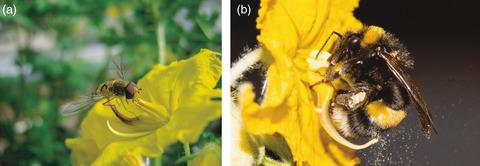Our official English website, www.x-mol.net, welcomes your
feedback! (Note: you will need to create a separate account there.)
Comparison of defence buzzes in hoverflies and buzz‐pollinating bees
Journal of Zoology ( IF 1.9 ) Pub Date : 2020-12-14 , DOI: 10.1111/jzo.12857 M. Vallejo‐Marín 1 , G. C. Vallejo 2
Journal of Zoology ( IF 1.9 ) Pub Date : 2020-12-14 , DOI: 10.1111/jzo.12857 M. Vallejo‐Marín 1 , G. C. Vallejo 2
Affiliation

|
Bees and many flies, particularly hoverflies (Syrphidae), have evolved a diverse range of mechanisms to gather pollen from a wide variety of flowering plants. Bees and hoverflies use protein‐rich pollen as a food resource to mature reproductive organs and eggs and, in bees, to feed their larvae. A particularly striking pollen‐collecting behaviour involves the production of thoracic vibrations to dislodge pollen from flowers. Vibratile pollen collection is widespread in bees (>11 600 species) but extremely rare in flies (~1 species of hoverfly). Why the use of floral vibrations to collect pollen is so rare among flies is currently unknown. A hypothesis proposed to explain why flies do not engage in vibratile or buzz pollination is that they are unable to reach the vibration amplitude required to expel pollen from anthers. Here we document, for the first time, the mechanical properties of non‐flight thoracic vibrations produced by hoverflies and compare them to the vibrations produced by buzz‐pollinating bees under similar contexts (defence buzzes). We analysed ~4000 vibrations produced by nearly 300 individuals representing 20 species of hoverflies and 22 bee taxa, recorded using a miniature piezoelectric accelerometer. We characterised both frequency and acceleration amplitude components of non‐flight thoracic vibrations and their relationship to insect size. Our results show that, after accounting for size, buzz‐pollinating bees and hoverflies produce vibrations with similar acceleration. We show experimentally that the acceleration amplitude produced by some hoverflies is sufficient to elicit pollen release from buzz‐pollinated flowers (Solanum dulcamara and S. rostratum). Our study does not support the hypothesis that the dearth of buzz‐pollinating flies is caused by their inability to produce vibrations of sufficient amplitude. We discuss alternative hypotheses to explain why most flies do not engage in buzz pollination and suggest that the lack of buzz‐pollinating flies might be best explained through their life history.
中文翻译:

蚜虫和蜜蜂授粉蜂的防御性嗡嗡声比较
蜜蜂和许多苍蝇,尤其是蚜蝇(Syrphidae),已经进化出多种机制来从各种各样的开花植物中采集花粉。蜜蜂和盘旋蝇利用富含蛋白质的花粉作为食物来成熟生殖器官和卵,并在蜜蜂中喂食其幼虫。特别惊人的花粉收集行为涉及胸腔振动的产生,以将花粉从花上驱除。蜂中花粉的采集很普遍(> 11 600种),而果蝇中则极少见(约1种蚜蝇)。目前尚不清楚为什么在果蝇中如此罕见地使用花振动来收集花粉的原因。提出一个假设来解释为什么苍蝇不参与振动或嗡嗡声授粉是因为它们无法达到将花粉从花药中驱除所需的振动幅度。我们在这里记录 首次研究了由悬停蝇产生的非飞行胸腔振动的机械特性,并将其与在类似情况下(防御嗡嗡声)的蜂传粉蜜蜂产生的振动进行了比较。我们使用微型压电加速度计分析了代表300种代表20种蚜虫和22种蜂类群的近300个人产生的大约4000次振动。我们表征了非飞行胸腔振动的频率和加速度振幅成分,以及它们与昆虫大小的关系。我们的结果表明,在考虑了大小之后,嗡嗡传粉的蜜蜂和盘旋蝇会产生具有类似加速度的振动。我们通过实验表明,某些蚜虫产生的加速度振幅足以引起蜂花粉授粉的花粉释放(盘旋蝇产生的非飞行胸腔振动的机械特性,并将其与在类似情况下(防御嗡嗡声)的蜜蜂授粉的蜜蜂产生的振动进行比较。我们使用微型压电加速度计分析了代表300种代表20种蚜虫和22种蜂类群的近300个人产生的大约4000次振动。我们表征了非飞行胸腔振动的频率和加速度振幅成分,以及它们与昆虫大小的关系。我们的结果表明,在考虑了大小之后,嗡嗡传粉的蜜蜂和盘旋蝇会产生具有类似加速度的振动。我们通过实验表明,某些蚜虫产生的加速度振幅足以引起蜂花粉授粉的花粉释放(盘旋蝇产生的非飞行胸腔振动的机械特性,并将其与在类似情况下(防御嗡嗡声)的蜜蜂授粉的蜜蜂产生的振动进行比较。我们使用微型压电加速度计分析了代表300种代表20种蚜虫和22种蜂类群的近300个人产生的大约4000次振动。我们表征了非飞行胸腔振动的频率和加速度振幅成分,以及它们与昆虫大小的关系。我们的结果表明,在考虑了大小之后,嗡嗡传粉的蜜蜂和盘旋蝇会产生具有类似加速度的振动。我们通过实验表明,某些蚜虫产生的加速度振幅足以引起蜂花粉授粉的花粉释放(Solanum dulcamara和S. rostratum)。我们的研究不支持以下假设:嗡嗡授粉的苍蝇缺乏是由于它们无法产生足够幅度的振动所致。我们讨论了其他假设,以解释为什么大多数果蝇不进行嗡嗡声授粉,并建议通过其生活史来最好地解释缺乏蜂鸣传粉的苍蝇。
更新日期:2020-12-14
中文翻译:

蚜虫和蜜蜂授粉蜂的防御性嗡嗡声比较
蜜蜂和许多苍蝇,尤其是蚜蝇(Syrphidae),已经进化出多种机制来从各种各样的开花植物中采集花粉。蜜蜂和盘旋蝇利用富含蛋白质的花粉作为食物来成熟生殖器官和卵,并在蜜蜂中喂食其幼虫。特别惊人的花粉收集行为涉及胸腔振动的产生,以将花粉从花上驱除。蜂中花粉的采集很普遍(> 11 600种),而果蝇中则极少见(约1种蚜蝇)。目前尚不清楚为什么在果蝇中如此罕见地使用花振动来收集花粉的原因。提出一个假设来解释为什么苍蝇不参与振动或嗡嗡声授粉是因为它们无法达到将花粉从花药中驱除所需的振动幅度。我们在这里记录 首次研究了由悬停蝇产生的非飞行胸腔振动的机械特性,并将其与在类似情况下(防御嗡嗡声)的蜂传粉蜜蜂产生的振动进行了比较。我们使用微型压电加速度计分析了代表300种代表20种蚜虫和22种蜂类群的近300个人产生的大约4000次振动。我们表征了非飞行胸腔振动的频率和加速度振幅成分,以及它们与昆虫大小的关系。我们的结果表明,在考虑了大小之后,嗡嗡传粉的蜜蜂和盘旋蝇会产生具有类似加速度的振动。我们通过实验表明,某些蚜虫产生的加速度振幅足以引起蜂花粉授粉的花粉释放(盘旋蝇产生的非飞行胸腔振动的机械特性,并将其与在类似情况下(防御嗡嗡声)的蜜蜂授粉的蜜蜂产生的振动进行比较。我们使用微型压电加速度计分析了代表300种代表20种蚜虫和22种蜂类群的近300个人产生的大约4000次振动。我们表征了非飞行胸腔振动的频率和加速度振幅成分,以及它们与昆虫大小的关系。我们的结果表明,在考虑了大小之后,嗡嗡传粉的蜜蜂和盘旋蝇会产生具有类似加速度的振动。我们通过实验表明,某些蚜虫产生的加速度振幅足以引起蜂花粉授粉的花粉释放(盘旋蝇产生的非飞行胸腔振动的机械特性,并将其与在类似情况下(防御嗡嗡声)的蜜蜂授粉的蜜蜂产生的振动进行比较。我们使用微型压电加速度计分析了代表300种代表20种蚜虫和22种蜂类群的近300个人产生的大约4000次振动。我们表征了非飞行胸腔振动的频率和加速度振幅成分,以及它们与昆虫大小的关系。我们的结果表明,在考虑了大小之后,嗡嗡传粉的蜜蜂和盘旋蝇会产生具有类似加速度的振动。我们通过实验表明,某些蚜虫产生的加速度振幅足以引起蜂花粉授粉的花粉释放(Solanum dulcamara和S. rostratum)。我们的研究不支持以下假设:嗡嗡授粉的苍蝇缺乏是由于它们无法产生足够幅度的振动所致。我们讨论了其他假设,以解释为什么大多数果蝇不进行嗡嗡声授粉,并建议通过其生活史来最好地解释缺乏蜂鸣传粉的苍蝇。










































 京公网安备 11010802027423号
京公网安备 11010802027423号